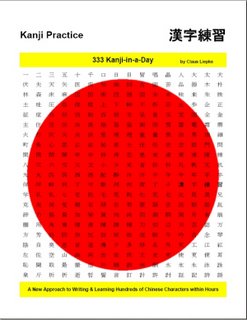Wednesday, November 22, 2006
333 Kanji-in-a-Day
Another Milestone - keeping this idea for more than 20 years in my mind ... I finally finished a Kanji teaching course book: 333 Kanji-in-a-Day. It is published as an eBook at Lulu.com and free excerpts are available at Kanji-Sudoku.com
 A new approach to writing & learning hundreds of Chinese characters within hours
A new approach to writing & learning hundreds of Chinese characters within hoursGenerations of students have experienced many months of frustrating learning efforts caused by poor language learning methodology. A new mind blowing learning technology introduced in this course book will revolutionize the access to the Japanese and Chinese languages. Writing and memorizing of Chinese characters can now easily be done.
Chinese characters (Hanzi) - also used in the Japanese language (Kanji) - are arranged by their 'looks' (shape) instead of their meanings. Small groups of six similar characters each will help you to save precious time exercising writing and reading. Learning speed will be improved by creating a solid base of at least 333 Kanji just within hours. And this will boost your motivation to learn the Japanese language.
Get ready for the Asian Century.
About this eBook:
Many years of educational research unveiled a stunning fact: Chinese characters are traditionally introduced by their contextual meanings instead of their shape. And this considerably slowed down the language acquisition process. This course book offers a new approach to writing and learning Chinese characters (Kanji in the Japanese language, Hanzi in the Chinese language). By arranging the Kanji in small groups of similar shape on tracing sheets your learning performance will be increased.
Our brain really loves motoric reinforcement while learning through writing practice. Little numbers attached to some strokes are explaining the correct stroke order and writing direction. In contrast to all other educational resources the numbers will only be displayed where necessary as your feeling of the correct writing and stroke order will grow from page to page.
Readings (or pronunciation) are given both: in Japanese kana and transliteration (Hepburn system). CAPITALS and katakana are used for on-readings (Chinese origin), hiragana for kun-readings (Japanese origin).
If you are totally new to the Japanese language, please make use of additional resources and concentrate on writing and meanings while using this course book.
Use only one line of the tracing sheet per kanji and training cycle - repeating of the readings and meanings of the Kanji will help you to kill practice time :-)
If in doubt how to write a Kanji please use your experience: When there is no number displayed, the stroke order and writing is as you have previously learned (assuming that you started this course book from the very beginning).
Two printed fonts of each Kanji are displayed to help understand the small differences in their appearance especially when handwriting is concerned.
---
So far about the new content at www.Kanji-Sudoku.com - I'll come back to you soon :-)